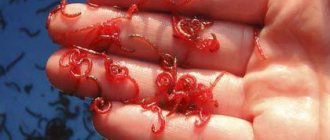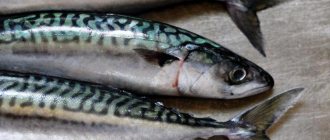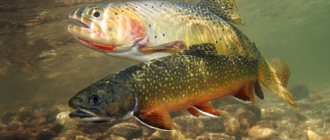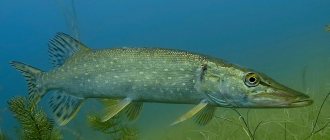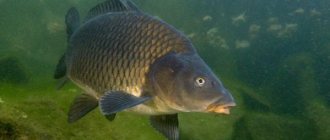Atlantic herring and its other varieties are rightfully included in the menu of national cuisines of many countries.
Many different dishes are prepared from these types of fish - sometimes very exotic, such as the Swedish surströmming, famous for its stunning aroma, or the Jewish forshmak, which has gone from the poor table to the famous gourmet restaurants. And the herring fish has been noted in history, literature, proverbs, and it even has its own holiday: Herring Day is celebrated in the Netherlands and Kaliningrad, and in Finland a festival is held in its honor. Are you preparing salted herring?
- Yes 52%, 272 votes
272 votes 52%272 votes - 52% of all votes
- I buy ready-made 44%, 228 votes
228 votes 44%
228 votes - 44% of all votes
- No 3%, 17 votes
17 votes 3%
17 votes - 3% of all votes
- I don't eat fish 1%, 6 votes
6 votes 1%
6 votes - 1% of all votes
Total votes: 523
03.12.2019
×
You or from your IP have already voted.
a brief description of
Herring is a predator and one of the most valuable seafood (the world catch is approximately 20% of the total number of fish caught). It is food for larger fish such as cod, tuna and salmon.
What does it look like?
Herring has an elongated body shape that tapers slightly towards the base of the tail. The back is compacted, the head is almost the same size as the width of the body. The scales are large, have a silver or steel color, near the back the color is dark with a bluish tint, the belly is light.
The dorsal fin is short but high, the caudal fin is forked, both are dark in color. The number of vertebrae is approximately 55-60 pieces.
Dimensions and weight
On average, these fish grow to 20-25 cm and weigh from 250 to 500 g. The maximum length of herring is 45 cm and weighs up to 900 g.
Is this a freshwater or saltwater fish?
Herring is a marine fish, although river varieties are sometimes found, but this is a rare occurrence.
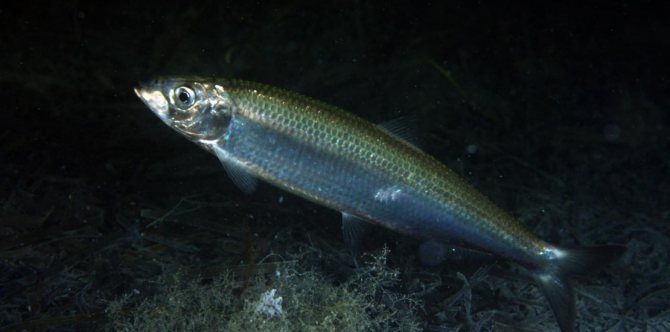
Where is it found?
Herring is found in the cold waters of the Atlantic and Pacific Oceans, mainly in the northern parts. You can also find schools of herring in the Baltic and White Seas.
Taste
This fish has a rich taste. Its meat is pinkish and juicy, and its texture is elastic. © https://ydoo.info/product/seld.htmlAfter heat treatment, the pulp becomes soft and tender, but holds its shape well and does not fall apart during cooking.
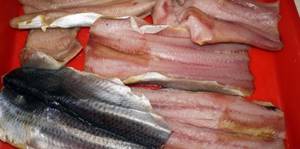
Smell
Herring has a specific marine aroma with subtle notes of algae. After cooking, the smell intensifies and becomes more pungent and pungent.
How bony and fatty are herring?
The fat content of this fish is about 20%, which makes the herring almost a delicacy. The carcasses have a long and dense backbone with elongated ribs. After its removal, a small amount of small bones remains, which are easy to pull out with tweezers. And after subjecting the fish to heat treatment, the small bones become soft and almost imperceptible to the taste.
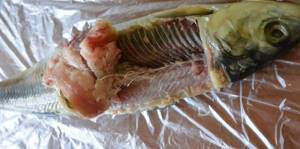
Origin of Sosvinskaya herring
In Rus', Sosva herring was called royal herring, since it was delivered directly to the royal table. In fact, Sosvinskaya herring is not a herring at all. It belongs to the whitefish family, a subfamily of salmon, and its closest relatives are omul, nelma and vendace. The real name of this fish is tugun , and it became Sosva due to its habitat. Tugun is an endemic, a species that lives in one place and does not swim far from its place of birth. It is found in a small tributary of the Ob, in Northern Sosva, near the village of Berezovo in the Khanty-Mansiysk Autonomous Okrug.
Types of herring
More than 60 species of herring have been recorded in nature, but the most commonly found on sale are 2:
- Atlantic - the most popular type of fish, which is constantly supplied to the shelves, characterized by a moderately long body size (up to 30 cm), as well as a silver color and low weight (up to 500 g);
- Pacific - differs from the Atlantic species in the larger size of the body (up to 38 cm), as well as the number of vertebrae (55 and 60, respectively), the color of the scales has a golden hue, and the body is evenly compacted, the fins are light.
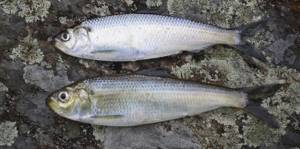
There is no difference between herring and herring, since they are the same fish, it’s just that the first name is official, the second is everyday.
Iwashi herring differs from regular herring in that they are different fish, since "ivashi" is the trade name of the Far Eastern sardine, which belongs to the same family, but belongs to a different genus - sardinops.
The Olyutor herring is a subspecies of the Pacific species and is found only in the western Bering Sea. It has high taste and a larger body weighing up to 2 kg.
How is it different from other fish?
Herring has the color and body shape typical of marine fish, therefore, in order to distinguish it from other varieties of marine life, one should take into account the characteristic features of the appearance of each representative.
From the sardine
Externally, these fish are similar, which is why herring is often confused with sardines. They can be distinguished by the size of their body, since the sardine is a small and thin fish, the body length of which is no more than 20 cm, and the weight does not exceed 100 g.
Herring tastes more meaty and juicy, since its meat contains more fat (about 2 times).

From mackerel
A characteristic feature of mackerel is the dark stripes that cover the upper half of the body (the back and up to the middle of the side surface), as well as the absence of scales.
In addition, these fish belong to different families and differ in fat percentage (mackerel has less) and taste.
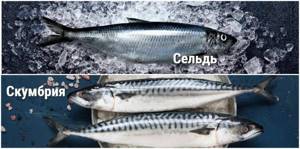
How to choose?
The most commonly found on sale are salted herring of varying degrees of salting, as well as fresh or frozen carcasses.
Salty
Before purchasing salted fish, you should pay attention to:
- brine, which should be transparent and not have any unpleasant odors;
- the carcass, which must be elastic and undamaged;
- gills, which should be intact (not falling apart) and dark red in color;
- the belly, which must be intact, without torn edges on the side of the head or tail;
- a smell that should be pleasant and characteristic (the absence of smell is also an alarming sign).
To choose a herring with caviar, you need to look for a fish with cloudy eyes, a flat back and a dense belly. The largest compaction and tubercle in the abdominal area should be located closer to the head.
To buy fish with milt, you need to choose carcasses with a slightly curved back and a soft belly, which is filled evenly.
If you want to buy lightly salted herring, then you need to choose fish with reddish eyes, but not deep red, as this may indicate that the carcass is raw.

Frozen
When choosing frozen herring you need to pay attention to the following features:
- if the fish was frozen in the usual way, then the ice crust should be thin and clean, and if using the dry method, then dry and hard, like a brick, without any growths;
- the shape of the herring should be natural (a tail bent to the side indicates re-freezing);
- the carcass should not only be clean from dirt, but also free of bruises.
If there are yellow streaks on the surface of the ice, then most likely the gall bladder has burst, which means that after defrosting the meat will taste bitter, so it is better not to buy such fish.

Fresh
Choosing chilled fish:
- It is better to take large carcasses, since the meat in them is fattier and tastier;
- the surface of the herring must be damp and clean, without mechanical damage, plaque or stains of a different color;
- eyes should be transparent, without clouding;
- the smell should be pleasant marine;
- the gills should be red in color;
- the carcass should be elastic to the touch.
If the fish is not just laid out on ice, but sprinkled with a large amount of it, then, most likely, the sellers are trying to cover up the smell and hide the fact that the carcasses have begun to rot.
Factors influencing catch
There are many ways to catch herring on the Don. First of all, you need to be patient. You won't be able to catch anything even in the best place if you don't have this quality. Remember that from the huge number of accessories that are offered in the store, you need to choose two or three, but such that they really work. The fisherman knows that the effectiveness of artificial bait is influenced by the following factors:
- the depth at which the school passes,
- water temperature,
- sun lighting,
- Times of Day.
The frequency with which the elastic band is twitched will also be affected.
It is important to determine the correct position in relation to the flow of water, to take into account changes in the depth of the river, the structure of the bottom, which can occur during spring floods or due to the operation of dredgers.
Catching Don herring is an art ; it will captivate anyone who picks up the gear. If you don’t succeed right away, use the experience of experienced fishermen, take a closer look at their fishing methods, listen to their advice.
How to store?
Depending on what kind of fish was purchased (fresh, salted, frozen), the conditions and shelf life of the herring change.
Conditions
Before storing fresh fish in the refrigerator or freezer, it is necessary to clean it, gut the abdominal cavity, carefully removing the black film from the inside of the belly and any remaining blood. You can also immediately cut off the head and remove the fins.
Herring should be stored in the refrigerator at a temperature of 3 to 5 degrees above zero, in a container with a lid and away from other foods. You can also place pieces of ice at the bottom of the container.
Salted herring can be stored in the packaging in which it was sold (if any), or in brine in the refrigerator, or you can place the fish in a container with a lid.
In addition, a salted carcass, like a fresh one, can be frozen, but first the herring should be removed from the entrails, washed, dried with a napkin and placed in an airtight container or vacuum bag.

Term
How long can you keep herring in the refrigerator? Fresh fish can be kept there for 2 days, but only if the carcass has been cleaned, otherwise the period is reduced to 1 day. Salted fish in vacuum or plastic packaging (in brine) can be stored for 35 days; after opening the container, the shelf life is reduced to 2 days.
Both salted and fresh carcasses can be kept in the freezer for 3 months.
Skinless herring fillets or pieces in brine can be stored at a temperature of 1 to 5 degrees Celsius for 4 weeks.
Appearance and varieties
Herring
Typically, the maximum lifespan of a herring is up to 25 years. Average individuals have a body length of up to 35 centimeters: they do not claim to be the largest fish. However, some individuals can grow to a length of more than 40 centimeters. Today, long-livers among this fish are extremely rare. This is due to the fact that large quantities of this fish are exterminated by predators and fishing. But in the 30s of the 20th century it was very often possible to meet a centenarian.
In nature, there are many varieties of this fish depending on their habitat. The most common among them are the Atlantic and Pacific, which practically do not differ from each other. Until recently, Pacific representatives were considered a subspecies of the Atlantic. Even experienced specialists find it very difficult to distinguish these 2 types of herring by external characteristics. Most of all, they are distinguished by the number of vertebrae: the Atlantic herring has from 55 to 57 vertebrae, and the Pacific herring has a maximum of 55 vertebrae.
Herring is a pelagic schooling fish. Some individual species of herring prefer brackish waters of bays. In the ocean ecosystem, herring is of great importance. It feeds on zooplankton. At the same time, herring is a source of food for other predators.
How to prepare?
Before preparing the dish, the herring must be carefully and correctly cut so that the meat does not have a bitter taste or pungent odor.
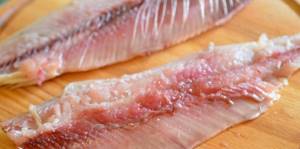
How to cut and clean?
The cooled herring should be rinsed well under running water and then the scales should be peeled off. If the skin will be removed from the fish, this step can be skipped.
To quickly and correctly cut a herring, you need to:
- cut off the head;
- cut off the side fins;
- make an incision on the back on both sides of the fin and remove it;
- lay the carcass on its side and use scissors or a knife to cut the belly from the base of the tail to the head;
- remove the entrails and thoroughly clean the walls of the abdominal cavity from the black film;
- rinse the abdominal cavity with water;
- make a deep cut along the entire back (to the ridge);
- lift the edge of the skin and remove it (starting from the head and extending to the tail);
- Using a knife blade or your fingers, carefully separate the meat from the ridge on one side and slowly remove the first fillet so that the ribs remain on the ridge;
- carefully separate the backbone from the second fillet;
- clean the fillet from bones (feel both halves of the fish with your fingers and remove the remaining large bones; small ones will become soft and imperceptible after heat treatment).
Next, both fillets can be left whole or cut into pieces of any size.
Another way to fillet herring with virtually no bones can be seen in the video below.
How to marinate at home?
To ensure that the meat remains juicy and has a rich taste during cooking, the cut carcass should be marinated for 15-60 minutes before starting cooking.
To do this, it is enough to rub the herring, in addition to salt, with spices of your choice, for example, fish seasoning, black or white pepper, as well as spices and fragrant dried or fresh herbs. Afterwards, you need to sprinkle the carcass or pieces with lemon juice, mix well, cover the container with the fish with a plate and put it in a cool place to marinate.
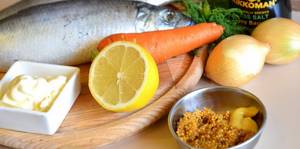
How to soak over-salted fish?
If you come across over-salted herring or simply want to reduce the salt content in order to use it for making salads, you can soak the fish in homemade milk, cold or hot water, as well as in strong fresh tea.
Before starting any type of soaking, the carcass should be rinsed well under running water and the abdominal cavity should be cleaned of entrails.
In milk or tea
After soaking, the meat will acquire a slightly sweet or milky taste, but the texture will become more tender.
The carcass can be placed in freshly brewed cooled tea with added sugar (to taste) or in unboiled milk. First, you need to cut the fish into 2 fillets and to speed up the process (if there is a lot of salt) cut into portions.
The herring should be soaked for 4 to 5 hours, changing the liquid at least a couple of times. The container with fish should be kept covered in the refrigerator.
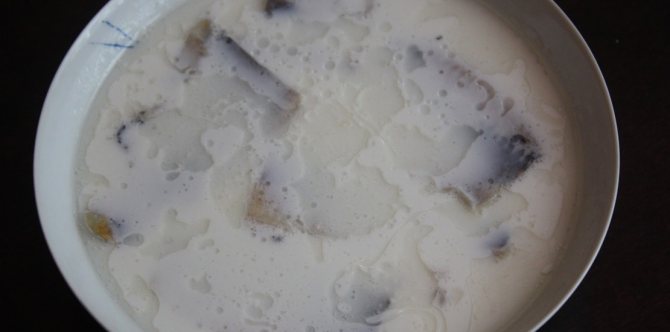
In water with vinegar
The carcass should be cut into 2 fillets, remove the entrails and bones and immerse in cold purified water with the addition of 70% bite in a ratio of 10:1, respectively.
The fish should be soaked for 12 hours, the liquid should be changed every 2-3 hours. The container with herring should be kept in the refrigerator or cool place.
You don’t have to add vinegar, but then the soaking time will increase to 24 hours. When the fish floats to the surface of the water, it means that it has lost a sufficient amount of salt and is ready to eat.
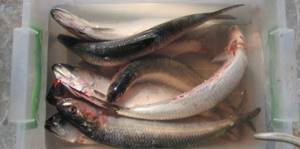
Fast way
A whole carcass without head and entrails should be placed in hot water for 1-2 minutes, depending on the size of the fish, and then immediately transferred to the sink and placed under running water for 5-10 minutes.
However, after such an emergency method, the taste of the herring may deteriorate slightly, and the structure of the meat will become softer and may no longer hold its shape.
Extraction methods
This is a fish of great commercial importance. It travels in huge flocks, and a whole fishing fleet goes out to fish: small, medium and large-tonnage vessels. “Little ones” only catch, unloading the catch to floating bases and factories, medium-sized vessels both deliver and process, and heavy-duty fishing trawlers catch, process on site and immediately freeze. They catch all year round, flights last from 2-3 days to 1 or more months. The location of the schools is determined using echo sounders. Fishermen claim that the schools of this fish resemble rocks and reefs under water: there are no other fish that move in such large schools.
They catch her in several ways:
- using two types of seine - ring and purse seine;
- pelagic trawl;
- nets using the driftnet fishing method.
All methods allow you to “capture” a huge number of fish at once - in 3 minutes you can pull out 100 tons, but fishermen try to catch no more than 60-70 at a time, so that the soft fish does not deform under its own weight.
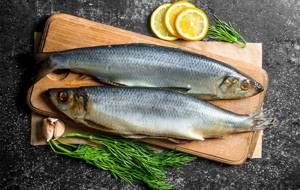
Cooking methods
Due to the fact that herring meat is fatty, it does not lose its juiciness and tenderness after almost any heat treatment. Fish can be baked in the oven, boiled, fried, stewed, steamed, etc.
How to bake the whole thing in the oven?
The herring is baked in the oven at a temperature of 200 degrees. Cooking time is approximately 25-35 minutes and depends on the size of the carcass, as well as whether it has been marinated.
Place the herring in foil, place a couple of slices of lemons in the cuts on the side surface, or simply place the carcass on a bed of them or any vegetables. The foil envelope should be opened 5-7 minutes before the fish is ready to get a golden brown crust.
Before baking, it is better to remove the gills from the head and thoroughly clean the abdominal cavity of the black film to avoid bitterness.
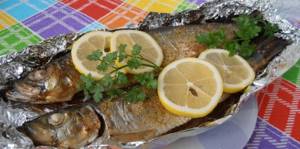
How to fry in a frying pan?
For frying, you can use either fresh, just caught fish, or freshly frozen or salted.
A freshly frozen carcass should first be thawed to room temperature.
To cook tasty, odorless herring at home, you need to:
- clean the carcass of scales, entrails, and dark film;
- remove fins and head;
- cut the meat into portions 1.5-2 cm thick;
- marinate in spices and lemon juice for 30 minutes;
- Grate the lemon zest into the breading flour, add a little hot pepper and salt, mix;
- Roll each piece in breading until the entire surface is covered;
- fry in a well-heated frying pan in vegetable oil for 3-4 minutes on each side (medium heat).
If you place fish in a cold frying pan, the meat will stick and tear during frying.
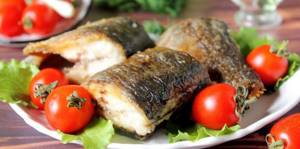
How to stew in a slow cooker?
To ensure that the fish acquires a beautiful ruddy hue during the stewing process, you can use freshly brewed black tea.
To prepare you need:
- clean the fish and remove the giblets and fins, cut the carcass into portions;
- Grease the bottom of the multicooker bowl with vegetable oil, lay out a layer of onion or white onion rings;
- put herring on top, sprinkle with salt, spices to taste and sprinkle with lemon juice;
- pour the ingredients with half a cup of strained strong black tea (1 tsp);
- Set the “Quenching” mode for 1 hour.
During cooking, the fish can be left undisturbed and served immediately after the end of the program.
You can stew fish in a pan, but how to saddle it correctly? can be seen in the video.
How to cook in the microwave?
The herring should be cleaned and cut into portions 2-3 cm thick. Marinate the slices in lemon juice, spices and salt for 15-20 minutes. Then stuff the belly with chopped onions.
You need to cook fish in a special microwave-safe container with a lid. Grease the bottom of the container with vegetable oil and place the pieces in one layer. Cover the container with a lid and place in the oven.
Bake on full power for 7 minutes, then check the fish for doneness. If the herring is not baked, then you need to turn the pieces over to the other side and cook for 5-7 minutes.
How to make it steamed?
The herring should be washed, removed from giblets and black film, cut off the head and remove all fins.
You can marinate the fish 20 minutes before cooking or rub it with spices and immediately place it in the bowl of a multicooker or steamer. In the first case, the meat will be more juicy and better saturated with spices.
On top of the carcasses you can place lemon slices in zest or dill sprigs. Cook for 20-25 minutes.
When cooking in a slow cooker, add bay leaves and allspice to the water for a rich aroma.
How to cook?
You can cook either a whole carcass or cut into pieces. Before cooking, the fish should be cleaned of internal organs, the head removed and the skin removed.
Fill a deep saucepan with water and put it on fire. When the liquid begins to boil, add fish spices, bay leaves and coarse or sea salt to taste. Then add the herring and cook for 25 minutes over medium heat, periodically skimming the foam from the surface of the liquid.
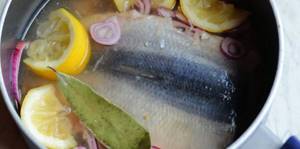
How to pickle?
There are two ways to salt fish at home: dry and in brine. Small herring, filleted or cut into pieces, will be salted faster than a whole carcass.
You cannot salt frozen fish; it is better to first defrost the carcass, clean it, and only then begin the procedure. Otherwise, the released moisture will spoil the brine.
Fresh herring can be salted whole immediately after purchase or catch, without preliminary procedures (other than cleaning).
In brine
To prepare herring you will need:
- remove carcasses from scales, heads or gills, as well as fins;
- remove the internal organs, clean the abdominal walls from the black film;
- rinse the fish thoroughly and then dry;
- if desired, fillet or cut the carcasses into portions;
- place the fish in a non-metallic container or jar on a layer of chopped onions;
- Boil 0.5 ml of water in a saucepan with 3 tbsp. l. coarse salt, 2 bay leaves, 3 allspice peas, and 2 tbsp. l. sugar, cook for 3-5 minutes;
- cool the brine;
- pour the liquid over the prepared fish, cover with a lid;
- After 3-4 hours, when the workpiece has cooled, put the container in the refrigerator.
The pieces will be salted after 24 hours, after being sent to the refrigerator, fillets - after 2 days, and whole carcasses - after 3-6 days (the time depends on what degree of salting you want to achieve).
The amount of ingredients is indicated for 2 carcasses weighing (after gutting and removing the head) no more than 800 g.
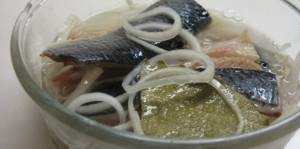
Dry method
To brine one carcass you need:
- wash the herring, remove the entrails, clean the black film from the walls of the belly, remove the head or cut out the gills;
- rinse the carcass and pat dry with a paper towel;
- mix 1 tsp in a container. sugar, 1 tbsp. l. coarse (non-iodized) salt and 1.5 tsp. ground black pepper;
- rub the fish with spices outside and inside, wrap in parchment paper or cling film;
- Place on the bottom shelf of the refrigerator for 2 days.
It is necessary to wrap the herring in parchment not in one, but in several layers, since during the salting process excess moisture will be released, which will soften the wrapper.
How to smoke?
You can smoke herring quickly using high temperatures and slowly by smoking the fish at a low temperature for a longer time.
Hot way
Before you start smoking, the carcasses should be removed from the entrails, as well as the gills (if desired, you can leave the head as well as the fins), then rinse the fish well and leave it for a while to dry.
Then 1 kg of herring (approximately 2-3 pieces) should be grated with 3 tbsp. l. coarse salt, if desired, you can add 1 tbsp. l. ground hot pepper. Afterwards, wrap the fish tightly in a damp cloth and place it in the refrigerator for 4 hours.
Next, the carcasses must be rinsed with cold water to remove any remaining unabsorbed salt, blot with a napkin and let lie in a draft for about 15-20 minutes so that the herring dries well.
Place soaked alder chips on the bottom of the smokehouse, install a grate above and place the fish, close the lid.
Smoke for half an hour over high heat, then remove the smokehouse from the heat and do not open the lid for another 30 minutes. After this, take out the herring, let it lie in the air for about 15 minutes - and you can serve it.
Cold way
To prepare the brine for the pre-salting of 3 herring carcasses required before smoking, you will need 1 liter of water, 100 g of coarse salt, 1 tbsp. l. granulated sugar, 2 bay leaves and 2-3 peas of black or allspice.
Cooking steps:
- remove the herring from the insides, black film on the inner walls of the abdomen and gills;
- rinse the carcasses under running water and wipe with a napkin to remove moisture;
- Boil water with all the spices in a saucepan for 4 minutes, cool;
- pour brine over the fish, cover the bowl with a lid and place in the refrigerator for 4-6 hours;
- rinse the herring, place on a mesh or in a colander until all excess liquid has drained;
- hang the carcasses to dry in the open air for 2 hours (in the summer they should be covered with gauze);
- Place the carcasses on a grid in a smokehouse for cold smoking and cook at a temperature of 25 degrees for 24 hours.
It is advisable to place wet alder chips or thin cherry twigs at the bottom of the smokehouse for aroma.
How to cook on the grill?
Before frying, it is necessary to remove the gills (or the entire head) and remove the entrails, and also thoroughly rinse the entire carcass (in particular the abdomen) with running water. Then wipe with a napkin and generously rub with coarse salt and add any spices as desired. Next, sprinkle the herring with ripe lemon juice and leave to marinate while the grill is lit.
When the coals burn evenly, you should install a grate on the grill, and place the fish on it, in the abdominal cavity of which you can put lemon chicken, sprigs of dill or parsley (in this case, the sides of the belly should be secured with wet toothpicks so that the filling does not fall out). Fry on both sides for 5-7 minutes until a uniform copper-colored crust appears.
To prevent the skin from sticking to the rods, the grate can be greased with a small amount of vegetable oil.
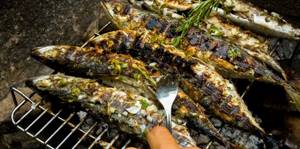
Methods of serving herring
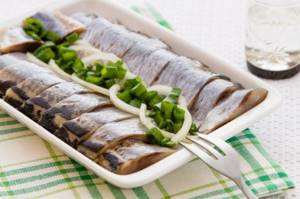
Various culinary traditions have come up with many ways to serve herring. For the Dutch, raw herring with green onions is considered a real delicacy, which can only be tasted during fishing in late spring - early summer.
In Russia, pickled herring is served cut into small pieces, drizzled with sunflower oil and sprinkled with chopped onions. In Scandinavian and German cuisines, pickled herring with rye bread, potatoes and even sour cream is popular. Herring has also become the basis of many popular dishes, such as herring salad under a fur coat and mincemeat.
The most inventive way to prepare herring was the Jewish community, which created many recipes, the most extravagant of which was chopped herring with crushed chocolate chip cookies.
Video
What spices and seasonings are suitable for herring?
For frying fish in a frying pan or grill, as well as for baking, you can use the following spices:
- black and red pepper;
- coriander;
- dried basil;
- a mixture of Italian herbs;
- paprika;
- lemon zest;
- French mustard.
For spicy salting of carcasses you can use:
- ground or whole bay leaf;
- ground coriander;
- any hot pepper;
- sugar;
- ground cloves;
- dried sage.
To steam herring you can use the following seasonings:
- Provencal herbs;
- black pepper;
- thyme;
- rosemary;
- basil.
You can add to the broth for cooking fish:
- peppercorns (any);
- Bay leaf;
- cloves;
- anise seeds.
In all recipes, in addition to salt, it is recommended to use the juice of large lemons, and you can also add fresh sprigs of herbs (dill and parsley).

Reducing the number of fish
Several years ago there was a lot of herring in the Don; it was caught not only by amateur fishermen, but also by fishing artels even in Rostov-on-Don itself. The fish had the opportunity to travel up the river over long distances, almost to Voronezh. Then there were many convenient places for spawning; herring could spawn everywhere. But the construction of the Tsimlyansk dam put an end to the free movement of fish along the river, which reduced the number of places for spawning grounds. And therefore, the herring population is declining from year to year.
In ancient times, the Don Cossacks caught fish simply with a hook with a red rag tied to it, but now they have to resort to various tricks to get herring. But still, the fish are caught well, there is still enough of it in the Don for all amateurs, if they are skilled fishermen.
What side dishes should I serve with?
For herring cooked in the oven, in a frying pan or steamed, the following side dishes are suitable:
- salad made from fresh vegetables, such as cucumbers, tomatoes with peppers or Chinese cabbage;
- boiled beans (both green and round) or potatoes;
- mashed potatoes;
- lentils;
- white or brown rice;
- baked or steamed vegetables;
- noodles.
Salted herring is an appetizer and goes well with classic fried or boiled potatoes, as well as white rice and omelet.

How to present fish beautifully?
Salted herring is a universal appetizer for any celebration, so to decorate the table with this dish, you can make a beautiful presentation of the fish. To serve the appetizer in an original way, the carcass must be cut correctly, that is, first fillet and remove all large bones, and then cut the meat into thin pieces.
Snack design options:
- Place thin pieces of herring on a circle of boiled potatoes, place a ring of pickled onion on top and tie all the ingredients with a green onion.
- Place fish pieces in an oblong dish in a herringbone pattern, top with pickled white onion rings and sprinkle with pomegranate seeds. Place chopped green onions around the edges of the plate.
- Lay the bottom of an elongated flat plate with onion rings; on top, maintaining the shape of the fillet, place two halves of the fish with their bellies facing each other. Place lemon half rings between them.
- Place the pieces of fish in the center of a large dish in the shape of a flower (rose), and along the edges in sections separated by olives, place various snacks, such as lemon, pickled mushrooms, cucumbers and sauerkraut. Sprinkle a little French mustard on top of the herring (for a pop of color).
- Place lettuce leaves on the bottom of the plate, slices of boiled potatoes on top, and place thin pieces of fish on them in the shape of a snowflake. Sprinkle chopped green onions on top, and place small parsley petals in the center, where the fish pieces meet.
In addition, herring can be served in the form of canapés, combined with boiled potatoes and pickled/canned mushrooms or garlic croutons.

Catching
Atlantic herring is one of the most popular and widespread species for industrial fishing. It goes on sale in a wide variety of forms - from frozen to canned.
For those who like solo fishing, it is better to go out for herring in spring or autumn. Just before spawning, the fish searches for and greedily grabs food, fattening up. You will have to move far enough into the sea to reach the required depth.
The best tackle would be a “tyrant” with a strong fishing line and 5-7 hooks with a long shank. In order for the tackle to sink to the bottom faster, the sinker must be round or drop-shaped, at least 200 grams. The rod, rigid and strong, should not be shorter than the tackle. To attract herring, you can attach bright feathers or bundles of thread to the hooks.
Herring spoons are often used as bait. The fish responds well to light and movement and mistakes the shimmer of metal for the reflection of fish scales. When choosing food bait, it is worth remembering that herring is a predator. This means that she will like small fish or pieces of fish and crayfish meat.
0
Author of the publication
offline 4 months
Benefits and harm to the body
Thanks to its rich vitamin composition, herring has a beneficial effect on people's health. Its meat contains fatty acids and minerals necessary for the functioning of the body.
It is most beneficial to eat fish boiled, baked, or steamed. For cooking, you can use both fresh and frozen herring.
Health benefits of this fish:
- the risk of developing heart disease is reduced;
- the likelihood of blood clots forming in blood vessels decreases;
- blood flow in capillaries improves;
- manifestations of psoriasis decrease;
- brain function increases;
- vision improves;
- the level of bad cholesterol decreases.
Salted, lightly salted and spiced fish has almost the same beneficial properties, but due to the large amount of salt it contains, it has more contraindications for consumption than, for example, baked or boiled herring.

When grilled or barbecued without the use of oil, herring retains many useful elements, which to a lesser extent, but have the same beneficial effect on the functioning of the body as steamed fish.
Store-bought preserves in oil also contain omega-3 fatty acids, which have a positive effect on health, but they should be consumed in limited quantities due to their fat content and salt (2-3 pieces a couple of times a week). However, it is better to give preference to independently salted or marinated fish, during the preparation of which no preservatives, flavor enhancers or drugs were used to increase shelf life.
Canned fish is high in calories, and after heat treatment and sealing, the meat retains a minimum of beneficial properties.
Benefits of herring caviar:
- normalizes hematopoiesis;
- improves the functioning of the cardiovascular system;
- speeds up metabolism;
- removes waste and toxins from the body;
- reduces the likelihood of tumor formation;
- normalizes blood pressure;
- reduces the likelihood of developing varicose veins;
- thins the blood;
- normalizes thyroid function;
- improves the functioning of the nervous system;
- improves mood;
- strengthens bones and joints.
Beneficial properties of milk:
- accelerate recovery after physical exertion or serious illness;
- improve heart function;
- reduce the likelihood of stroke and heart attack;
- improve brain activity;
- activate the immune system.
Herring is harmful to health for people with allergies to seafood or individual intolerance. Boiled, baked and steamed fish can be eaten by almost everyone, but salted fish (all types and brines), as well as canned and preserved fish in oil should be avoided by people with hypertension, kidney and liver diseases, as well as in the presence of edema. In addition, foods with salt retain fluid in the body, which can lead to the formation of swelling in a healthy person, so you should not overuse the snack (no more than 100 g per day and no more than once a week).
Fried and smoked fish should be excluded from the diet by people with heart disease, high cholesterol, and those who are obese.
Women
During pregnancy, women are recommended to add boiled or steamed herring to their diet, as it contains many useful elements and fatty acids that will positively affect the health of not only the expectant mother, but also the baby.
When breastfeeding, it is also not contraindicated to eat boiled or steamed herring.
However, nursing mothers and pregnant women should avoid salted herring, as this can lead to worsening swelling and deterioration in the quality of milk, which will negatively affect the baby’s health.
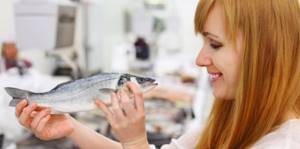
Men
Eating herring improves male potency, as well as the functioning of the circulatory system. In addition, fish contains protein, which is quickly and almost completely absorbed by the body, which helps strengthen muscle tissue (especially useful for athletes).
Children
Salty foods, including herring, are not particularly beneficial for a child’s health, so for a growing body it is better to steam or bake foods.
You cannot add herring to food before the child turns 3 years old. The daily dose should not exceed 30 g, use no more than once a week. With age, the amount of fish can be increased if the baby does not have a negative reaction to the product.

Weight loss and diet
Eating herring boiled, steamed or baked in its juice with lemon helps speed up metabolism, which has a beneficial effect on the process of losing weight. In addition, you can add fish caviar to your diet, which increases endurance and saturates the body with essential minerals and vitamins, which it may be deprived of due to a strict diet.
Salted or smoked herring should not be consumed, as this will slow down the weight loss process.
It is recommended to eat fish at lunchtime so that it has time to digest. However, due to the increased fat content of this sea fish, the daily dose of its consumption should not exceed 150 g, and you can eat it no more than 2 times a week.

Herring and... the Queen of England
From this batch the keg was sent straight to the UK. For many years, the Sosva miracle has been served daily for breakfast to the Queen of England. A one-of-a-kind agreement was concluded between the countries, according to which Great Britain was allowed to trawler tugun in Berezovo once a year for exactly an hour and not a second more. The catch was weighed and a check was issued.
Everyone wanted to try this miracle fish. Therefore, they guarded her accordingly. In the USSR, the fine for poachers for catching tugun was 25 rubles per fish, and for the no less valuable and tasty sturgeon they were fined only 5 rubles.
Herring for diseases
Due to the fact that herring is a fish with fatty meat, people whose illnesses force them to follow a certain diet must carefully introduce this delicacy into their diet, especially if the fish is not steamed, but salted.
Gastritis
People suffering from gastritis need to adhere to a certain diet so as not to aggravate their health condition. Fish with a high fat content should be excluded from the diet. Therefore, it is advisable to avoid herring.

Pancreatitis
For chronic pancreatitis, you can eat boiled herring, the fat content of which does not exceed 12%. Fatty fish should be excluded from the diet. During an exacerbation of the disease, herring must be completely removed from the diet.
Please note that the degree of fat content of the meat depends on the herring’s habitat.
High cholesterol
You can eat boiled and steamed fish, which will help lower blood cholesterol levels, but you need to eat meat in limited quantities (no more than 150 g 1-2 times a week). Salted or smoked herring should be completely avoided.
Gout
Herring meat contains a large amount of purines, which are prohibited for people with gout, so this fish must be excluded from the patient’s diet.
Diabetes
Since herring meat contains virtually no carbohydrates, this fish can be eaten by people with diabetes, but only boiled, baked, steamed or lightly salted. The latter must be eaten carefully, very rarely and in small quantities (no more than 2 pieces), since salt retains fluid in the body, causing glucose to be absorbed more slowly, which in turn can lead to a surge in insulin.

Interesting Facts
Initially, herring was the food of the poor and monks, since the taste of its meat was bitter, and no one liked it. Then in Holland, one fisherman thought of removing the gills before salting, which completely removed the bitter taste and made the fish a real delicacy.
Herring became so popular that countries such as Norway, Poland, and Latvia began adding its image to their coats of arms.
In honor of this fish, several museums have been opened, which are located in Germany, Sweden, as well as Finland and Russia.
In Holland there is a national holiday called “Herring Day” and is celebrated on June 17th.
In England, herring was served with tea and was available only to aristocrats until the beginning of the 14th century, when they learned to smoke this fish. After that, it became available to all residents.
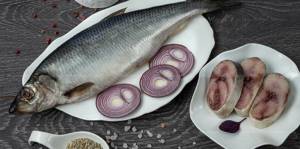
Herring is a fatty sea fish that lives in the Atlantic and Pacific Oceans, characterized by juicy meat with a rich taste and aroma. Widely used in cooking around the world. It is beneficial for the health of adults and children, especially when boiled or baked. It has almost no contraindications, but salted and smoked fish should be consumed in moderation.
Behavior and nutrition
Atlantic herring are characterized by a complex migration route, different even for different schools of fish. The main purpose of such movements is to gain weight and reproduce. In early spring, mainly herds of young animals under the age of 8 years enter the Barents Sea. Here they feed until maturity and rush to spawn on the shores of Norway, Iceland, and the Faroe Islands.
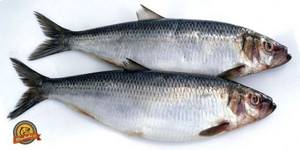
After spawning, the herring weakens so much that it is carried away by the current until it regains its strength and moves further north to the shores of Spitsbergen for further feeding. By mid-summer they eat off and mature for new spawning. This fertility is due to the great popularity of herring among predators. Some subspecies of Atlantic herring, such as herring, spawn almost all year round.
Herring prefers the upper layers of water - no lower than 200 meters. Almost always on the move. It feeds on the go, which determines the shape of its mouth. Its menu mainly consists of small fish and small crustaceans.



